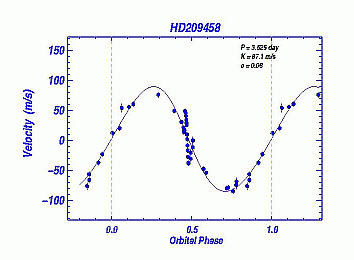
Transit of the star HD209458
Since 1999, it has been known that a Jupiter-mass planet orbits the star HD209458 (spectral class estimates F8V to G0V) every 3.52 days. Initial discovery was via spectroscopic radial velocity measurements; later in that year, it was found by the STARE project that a photometric dip occurred at the time expected from the spectroscopic orbital parameters. This was the first such detection (or more correctly, confirmation) of an exoplanet by photometric means.
Since then, several groups and individual observers have observed these transits photometrically. The dip in brightness around mid-transit is some 1.7% and this, coupled with the fact that the star is reasonably bright, means that a CCD camera on a small telescope may readily observe this phenomenon.
Some graphs, gathered from the Web, are shown below (note that the web-site's author may not necessarily be the original source of the data displayed, or of the plot itself):

Radial velocity plot from Geoff Marcy's web-site
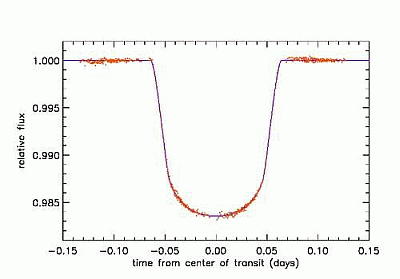
Photometric plot from Bruce Gary's web-site; Hubble telescope data
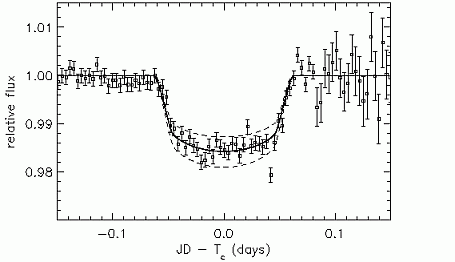
Photometric data from the STARE project; 4" telescope
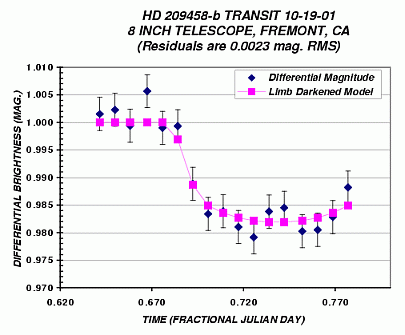
Data from Tim Castellano and Greg Laughlin; 8" telescope
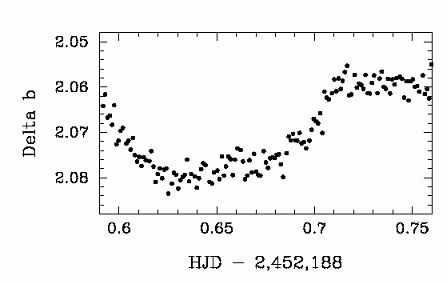
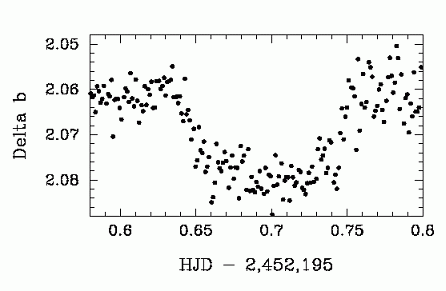
Two plots from Gregory Henry; 32" with photoelectric photometer
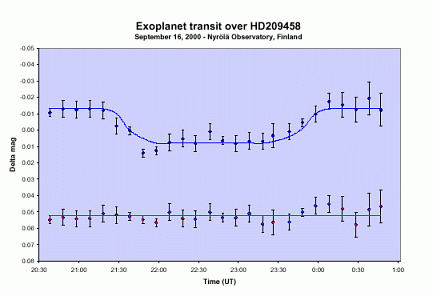
Data from Nyröla Observatory's 16" telescope- the first amateur observations
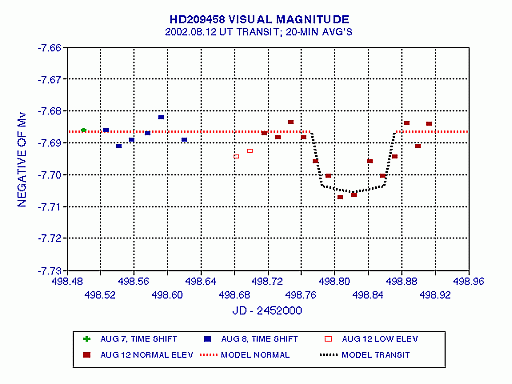
Data from Bruce Gary using an 8" telescope
Anders Nyholm of the Astronomical Society Tycho Brahe has prepared a report on his observations of October 2003. It's available here.
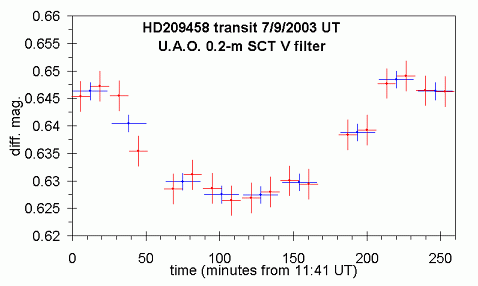
Data from the University of Adelaide Observatory (8"). Red points show ten-point averages (error ±0.0028mag); blue points show twenty-point averages (error ±0.0017mag). For more information, see below.
The plots above show a variety of professional and amateur observations of various transits. In all photometry, the dip due to the transit is clear, and of consistent duration and depth. It is often the case that individual magnitude estimates will be averaged in order to reduce the influence of noise in the data.
For the predicted transit of September 7th, 2003 13:47 UT, the UAO 0.2-metre Meade LX200 and SBIG ST-6 CCD were used to obtain time-series images of HD209458. Using a V filter, exposures were 35 seconds in duration so as not to approach the possibly non-linear section of the CCD's pixel capacity (peak intensities were in the low 30,000 ADU range). With a typical 40-second download time, time resolution was 75 seconds. Two breaks of about 10 minutes each were used for focusing and tracking checks.
From Adelaide, the star culminates at 37º elevation (or 1.66 air masses). One would therefore expect about 0.3 magnitudes of V-band extinction at such a time. For this particular instance, the time of mid-transit was not far removed from culmination. However, obstruction from buildings on campus meant that observations could not begin until about a half-hour before first contact.
The data were reduced differentially, and a dome flat-field was used. Observations began at 7/Sept/2003 11:41 UT (strictly speaking, 11:41:17 UT for mid-exposure of the first image), and continued until 16:00 UT. The plot below shows the results.
The nearby star (number from the Hipparcos satellite catalogue) H108793 (approximate co-ordinates 22:02:21.3 +18:50:00, mag = 8.232) was used as the comparison star for the differential reduction.
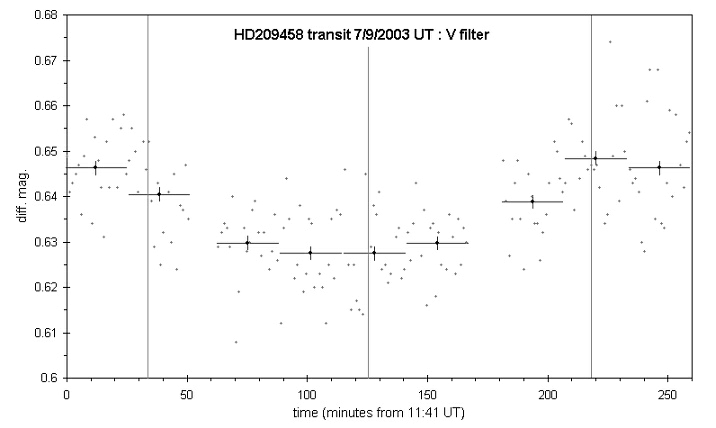
The small dots are the individual differential magnitudes; these were then binned into groups of twenty points and averaged, in order to yield the larger dots shown with error bars (note that the time width of the bins was kept essentially the same). The error bars show the time width of the bins (about 25 minutes), and the pooled estimate of the common standard deviation, with one-sigma being given; this is a common estimate for all averaged points, since the time-bin widths are the same, and the quality of the data throughout the run was fairly constant. The formula for determining this error estimate is as follows:
error = s.p. / sqrt (m)
where "sqrt" implies "square root" (and there are m = 20 points per average in this example), and where
s.p. = sqrt ( (sqr(s1) + sqr(s2) +.....+ sqr(sn) ) / n )
where "sqr" implies "squared", and s1, s2,...,sn are the standard deviations of the data within each of the n bins of data.
For the data shown above, this error estimate is 0.0017 magnitudes (round up to 0.002 if you like...).
The thin, grey vertical lines mark, from left-to-right, the approximate expected times of first contact, mid-transit, and last contact, respectively. The temporal resolution of these averaged data is not sufficient to resolve the finer features of the transit light-curve; the ST-6 CCD was used in full-frame, high-resolution mode, which involves some 40-seconds for the image to be digitised and downloaded after the exposure has finished.
The next plot shows the results of observations taken as part of a second-year project on this star. Exposures were 50-seconds long, the V filter was used, and data were again binned in groups of 20, and errors estimated as above. For this run, the telescope was put slightly out-of-focus, thus allowing longer exposures; by the time of the last average data point shown, the star was at an air mass of 2.7. The development of cloud cover terminated the observations. The one-sigma error estimate for the magnitudes is 0.002mag.
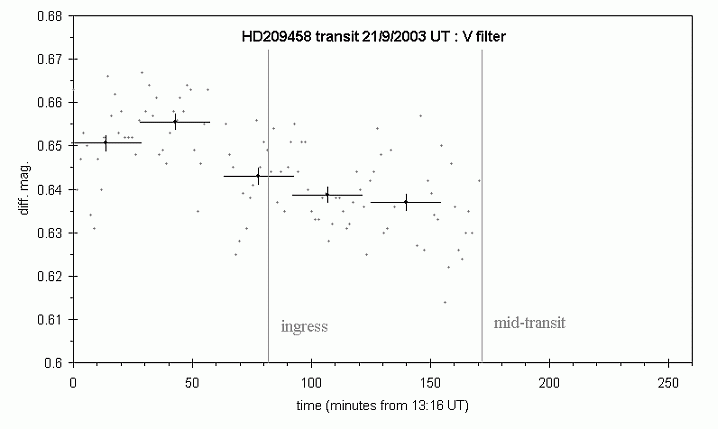
The data for Septmeber 7th are consistent with the expected time and duration of the transit, and the observed depth of 0.017mag also matches that of the other data presented earlier. Therefore, it is concluded that this transit was successfully observed. The thoroughly urban location of the Observatory, and the presence of a waxing gibbous moon in the sky at the time of observations, suggest that a valuable and valid programme of monitoring for such events may be undertaken even in what would often be considered harsh and uninviting conditions.
Shown below is a plot of data obtained on the local night of October 16th-17th 2003 (i.e. Oct. 16th 2003 UT). For these images, the R filter was used, exposures were 20-seconds, and the ST-6 was used with sub-frame download and at medium-resolution via the available on-chip binning. This resulted in a download time of 7.4-seonds; total time per image was therefore around 27.4 seconds, rather than 75 seconds, as for the September 7th data. Note that this was not the time of a transit; the flux from the star was steady.
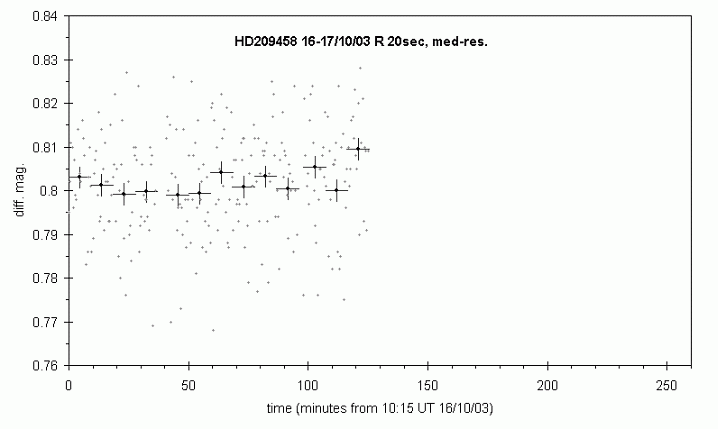
The same method of averaging and error estimation has been applied. Since all plots use 20 data points per average, the quality of each night's data may be directly compared. For the three nights' data, we have :
Sept. 7th error ± 0.0017 mags / Sept. 21st error ±0.0020 / Oct. 16th error ± 0.0027 mags
That is, the last data have an error about 1.5 times larger than that for the first two runs. This suggests (though it is not proven, since we have only one night's data taken with each observing regime) that the shorter-exposure/lower-resolution method is inherently less accurate. However, the errors are still small (a value of ±0.003 mags often being considered as quite acceptable), and yields a temporal resolution more than double that of the original regime. This last method may by no means be optimal, but a considerable amount of experimentation would be required to examine that question thoroughly.